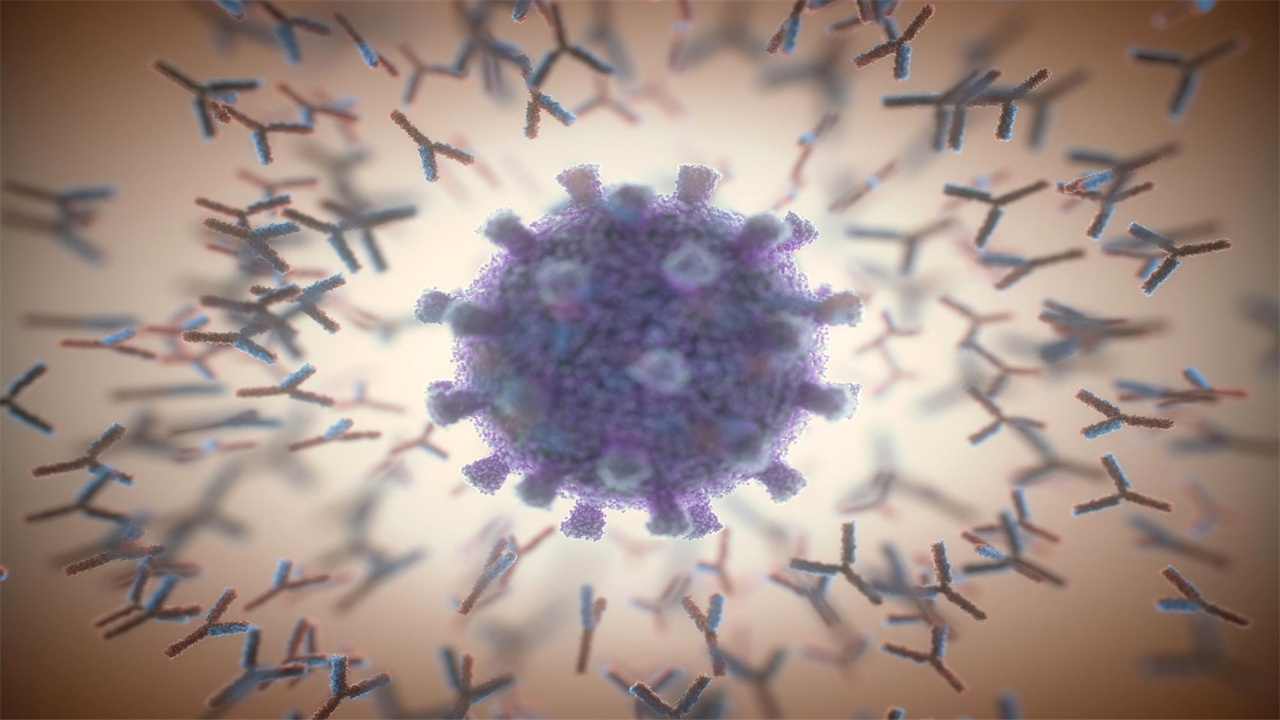“Inescapable” COVID-19 Antibody Discovery – Neutralizes All Known SARS-CoV-2 Strains
0 View
Share this Video
- Publish Date:
- 26 August, 2021
- Category:
- Covid
- Video License
- Standard License
- Imported From:
- Youtube
Tags

An artistic representation of antibodies surrounding a SARS-CoV-2 particle.
An antibody therapy that appears to neutralize all known SARS-CoV-2 strains and other coronaviruses has been developed with a little help from structural biologist Jay Nix.
Life-saving COVID-19 vaccines allow us to feel optimistic again after more than a year of fear and tragedy. But vaccines are only one side of the coin – we also need treatments that can prevent serious illness after someone is infected. Significant progress has been made in the past year in the development of effective antibody-based therapies, and three drugs are currently available through emergency authorization (EUA) by the Food and Drug Administration.
Sotrovimab, the latest antibody therapy, was developed by GlaxoSmithKline and Vir Biotechnology after a large collaborative study by scientists from across the country discovered a natural antibody (in the blood of a SARS survivor, in 2003) with remarkable scope and efficacy.
Experiments showed that this antibody, called S309, neutralizes all known SARS-CoV-2 strains — including newly emerged mutants that can now “escape” previous antibody therapies — as well as the closely related original SARS-CoV virus.
Jay Nix, leader of the Molecular Biology Consortium based at Berkeley Lab’s Advanced Light Source (ALS), used beamlines at the ALS and beamlines at SLAC’s Stanford Synchrotron Radiation Lightsource to perform X-ray crystallography on samples of survivor-derived antibodies during an early phase of the study. His work, among other findings in crystallography and cryoelectron microscopy, helped generate detailed structural maps of how these antibodies bind to the SARS-CoV-2 spike protein, enabling the broader team to identify the most promising contenders. and transfer them to cell culture. and animal studies. After exciting laboratory results, the developers designed sotrovimab based on the structure of S309 and evaluated it in clinical trials.
The FDA granted an EUA for sotrovimab in late May after studies showed that people with mild to moderate COVID-19 infections who received an infusion of the therapy had 85% fewer hospitalizations or deaths compared to placebo.
But the team didn’t stop there.
Understanding that new mutations could arise and that a new pathogenic coronavirus could emerge from an animal-human crossover event, the scientists began a follow-up study to explore in depth which factors make antibodies resistant to viral escape. and how certain antibodies are also broadly reactive against various, related viruses. Using biochemical and structural analysis, in-depth mutation scanning and binding experiments, they identified one antibody with unparalleled universal potency.
“This antibody, which binds to a previously unknown site on the coronavirus spike protein, appears to neutralize all known sarbecoviruses — the genus of coronaviruses that cause respiratory infections in mammals,” said Nix, an affiliate in Berkeley Lab’s Biosciences Area. . “And because of the unique binding site on the mutation-resistant part of the virus, it can be more difficult for a new strain to escape.”
Subsequent tests in hamsters suggest that this antibody could even prevent COVID-19 infection if given prophylactically. The new work is published in Nature.
Reference: “SARS-CoV-2 RBD Antibodies That Maximize Latitude and Resistance to Escape” by Tyler N. Starr, Nadine Czudnochowski, Zhuoming Liu, Fabrizia Zatta, Young-Jun Park, Amin Addetia, Dora Pinto, Martina Beltramello, Patrick Hernandez, Allison J. Greaney, Roberta Marzi, William G. Glass, Ivy Zhang, Adam S. Dingens, John E. Bowen, M. Alejandra Tortorici, Alexandra C. Walls, Jason A. Wojcechowskyj, Anna De Marco, Laura E. Rosen, Jiayi Zhou, Martin Montiel-Ruiz, Hannah Kaiser, Josh Dillen, Heather Tucker, Jessica Bassi, Chiara Silacci-Fregni, Michael P. Housley, Julia di Iulio, Gloria Lombardo, Maria Agostini, Nicole Sprugasci, Katja Culap, Stefano Jaconi , Marcel Meury, Exequiel Dellota, Rana Abdelnabi, Shi-Yan Caroline Foo, Elisabetta Cameroni, Spencer Stumpf, Tristan I. Croll, Jay C. Nix, Colin Havenar-Daughton, Luca Piccoli, Fabio Benigni, Johan Neyts, Amalio Telenti, Florian A. Lempp, Matteo S. Pizzuto, John D. Chodera, Christy M. Hebner, Herbert W. Virgin, Sean P J Whelan, David Veesler, Davide Corti, Jesse D. Bloom, and Gyorgy Snell, July 14, 2021, Nature.
DOI: 10.1038/s41586-021-03807-6
The Advanced Light Source and SLAC’s Stanford Synchrotron Radiation Lightsource are Department of Energy Office of Science User Facilities.










